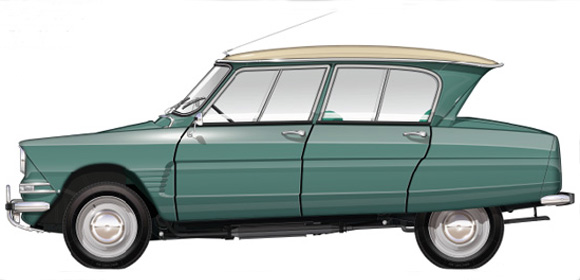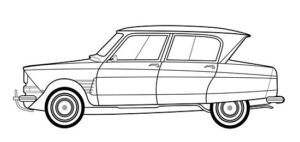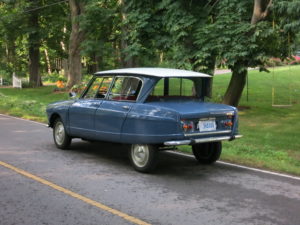by George Dyke…..
If there’s one Citroën that seems odd when you first see it, but after a while tends to grow on you, I think it’s the Ami 6.
Wherever you go it attracts head snapping stares. People’s eyes widen, mouths gape and then turn into broad smiles. Its a car that registers as being cute while at the same time being so different as to simultaneously stir up a negative reaction of ugly. Those opposites play off the grey matter for a few moments and then curiosity takes over with a desire to stare and see more.
While I have a 1964 Ami 6 and enjoy its quirky charm immensely, this past week I have had a second Ami 6 that I had a chance to both road test a gauge people’s reactions. It is a 1965 model, a rare car in its own right, but this one even more so. It is a US spec model, with differentiating features such as dual circular sealed beam headlamps and running light/turn signal indicators that are in cast aluminum pods that are positioned just below the headlights and protrude in the front.
The US spec Ami 6 was sold in Canada and the USA in very limited numbers and very few have survived to this day. This one came into the Toronto area by means of a purchase that the late John McCulloch made from a US owner in the mid-west USA about 10 years ago. From the side, a US spec and European spec Ami look the same.
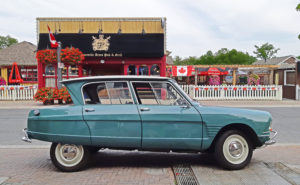 1965 US spec Ami 6 in Unionville, ON.
1965 US spec Ami 6 in Unionville, ON.
Last Thursday I took it for a drive to downtown Unionville, ON – a town just northeast of Toronto with a historic main street that attracts tourists and shoppers who love boutiques and collectables. I found a parking spot right outside the shops and in front of a café. I managed to find a seat at the outdoor table in front which gave a perfect view of the side of the car, and an appreciation for the sculpted style the Flamino Bertoni evoked on the last design he did for Citroën before his death in 1964.
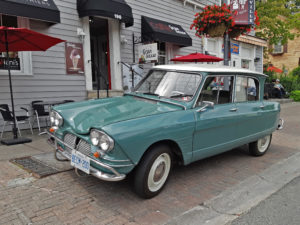 In front of Caffé Gran Sasso in Unionville, ON
In front of Caffé Gran Sasso in Unionville, ON
Bertoni was hired by Andre Citroën to bring an aesthetic design to the Traction Avant in the 1930’s. He was an Italian designer and sculptor who, having never designed a car before, decided to express his thoughts by sculpting it’s form in clay, a first for automotive design at the time and something that carries through to this day, despite the 3D CAD programs and automated tools for forming shapes that have now become ubiquitous in automotive design (and every other kind of design and manufacturing). The lines and subtleties to the Ami’s form happen from a feel and in-body expression of emotion that flows from the brain. Bertoni was a master of this, having gone on from the Traction Avant to design the 2CV and Citroen’s landmark DS. But before he passed away, he commented that the Ami 6 was his crowning achievement. Quite a statement considering what he had done beforehand, and when first looking at the Ami you wonder if he didn’t have dementia when he said it.
However, the more you look at the Ami 6, the more you realize that this design wasn’t about crafting the first unibody car like the Traction, or the aerodynamic and flowing lines of the DS. It wasn’t about the visual tension of curves that he applied to the 2CV. Rather, it was about all the elements Bertoni could muster that were the exact opposite. He was given the task of taking the mechanics of a 2CV and creating a sedan to launch in 1961 that would appeal to French ladies what thought the 2CV a bit too utilitarian. He felt that there was no point in doing a 3-box sedan design with relatively straight lines or a one that was rounded. The end result would be like every other 4-door car (unless of course one opted for the upscale DS or ID that Citroën offered). Instead, Bertoni decided to trigger a raw emotional response from people by making a design that was completely different yet cleverly balanced in its own right. It really was sheer genius. Sitting there, sipping my coffee and seeing the people that passed by invariably react to this quirky little car before them, the passion Bertoni applied to the Ami 6 resonated with me and gave me a greater appreciation of his last design accomplishment.
There are elements about the car that at first don’t make any sense until to look further at the car and see that they were added to make the car distinctive and ultimately do complement the vehicle. Try to imagine them not being there; The art-deco 5-bar embellishment on the front fender behind the wheel arch and how it sets the means for the side to be concave from that height and taper toward the rear. How, like the 2CV, he puts priority to the body underside to flow unobstructed to the rear and, with smooth side unbroken, to accommodate a rear fender does not have it protrude, unlike the 2CV, to accommodate the rear wheels. A body that looks to be draped over a completely different design toward the front, and roof with not only a reverse tilted rear window but a C pillar with two different diagonals echoing the drape effect from the front and visually narrowing the base to accentuate the rear roof overhang. Notice the upper side-crease line of the front fender extends to the rear in a graceful taper giving a hint of DS cabriolet flow, while also accenting the fluid motion effect to the upper part of the body. And that is just the side! The front, the back, – it is all so odd, yet so visually interesting, that it totally stands apart from any modern car today.
The Ami 6 is arguably the boldest design applied to any mass-produced automobile. Bertoni was more flamboyant with it than he had ever been, yet in doing so he made the Ami 6 more iconic in its own right. Love it, or hate it, it certainly gets recognized in a world where it is increasingly difficult to distinguish one car from the other.
